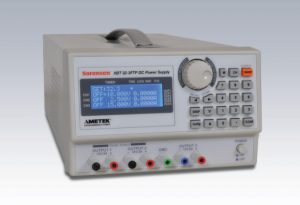An isolated power supply has a power output that is electrically independent of its power input. That is to say that there is no connection between the power input and the power output. When a power supply has multiple isolated power outputs, it means that the output voltages are independent of one another and there is no connection between the outputs.

There are several reasons why you might want to select a power supply with isolated outputs:
- Safety. Safety is perhaps the most important reason for a power supply's outputs to be isolated from the AC supply voltage. Isolation prevents AC mains voltage from being present on the output. This is the reason that isolation is of extreme importance for power supplies used in medical equipment. IEC 60601-1: Medical electrical equipment - Part 1: General requirements for basic safety and essential performance is the standard that spells out requirements for power supplies used in medical applications.
- Flexibility. Benchtop power supplies with multiple, isolated outputs, such as the Sorensen XBT Series, offer users the most flexibility. The XBT's isolated supplies can easily be connected in series to obtain higher output voltages or in parallel to obtain higher output currents.
- Ground loop prevention. Another reason to use an isolated power supply is to prevent ground loops. Ground loops occur when two or more circuits share a common return path. When your system has a ground loop, current flowing in the loop can cause one or more of the circuits to malfunction. Using an isolated power supply breaks the ground loop and prevents this interaction from happening.
Isolation between power input and power output or between two power outputs is never 100%. Insulators, for example, are not perfect and are conductive to some degree. This conductivity results in a leakage current. Insulators also have a finite breakdown voltage.
Other characteristics that reduce the level of isolation between two circuits are stray capacitance and mutual inductance. There is, for example, stray capacitance between the primary and secondary windings of a transformer, and this capacitance reduces the level of isolation between the power input and power output. Mutual inductance can also reduce the level of isolation between two circuits. If this is a problem for you, the solution is to increase the distance between the two circuits.
There are two ways to measure isolation between two circuits. One way is to measure the resistance. Because the resistances are so high—20 Mohms or more—you may need more than just a typical multimeter to make this measurement. Another way to measure isolation is to perform a “Hi-Pot” test. To run this test, you apply a high DC or an AC voltage across the two circuits and measure the leakage current. There are testers specifically designed to run this test.
In addition to isolated outputs, you might also want to consider whether or not a supply's control inputs—both analog and digital—are isolated. Isolated inputs will help ensure that control circuits don't affect the power supply output and vice versa. For more information on power supply isolation, contact AMETEK Programmable Power. You can send an e-mail to sales.ppd@ametek.com or phone 800-733-5427.
